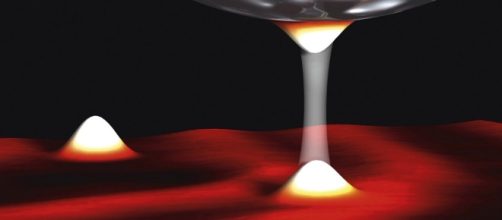Scientists at the Max Planck Institute for Solid Research lowered their scanning tunneling microscope to a low temperature of fifteen thousandth of a degree above absolute zero to reveal the electric current turns to a granulated medium that consists of discrete particles. According to the Max Planck Society, in this state, the particles do not flow like electric current, but trickle like the tiny grains sliding through an hourglass. Although is not possible to distinguish individual electrons, Quantum mechanics state that they exist and the researchers were able to observe this nature in a tunneling current.
Scanning tunneling microscope
This telescope was developed on the concept of Quantum tunneling. When a conducting tip is placed over a sample to be examined, a voltage is applied in between the tip and the sample to allow the electrons to tunnel in between the vacuum separating them. The tunneling current is a function of the tip´s separation, the applied voltage and the local density states of the sample. Variations in the tunneling voltage lets scientists study individual atoms and their atomic structure.
Quantum characteristics at almost absolute zero
To observe the quantum behavior of individual electrons, scientists had to cool the microscope to approximately a fifteen thousandth of a degree above absolute zero temperature before they could observe that the electric current is composed of discrete electrons.
It is at this extreme temperature that the tunneling current is no longer homogeneous and turns into perceptible separate electrons. This marks the first time that the quantum nature of electrons has been revealed.
Quantum tunneling technique
In order to perform observations with a scanning tunneling microscope, it´s necessary to have extremely clean and stable surfaces, very tiny pointed tips and environment free of vibrations, plus very advanced electronics. To provide all of these requirements, the Max Planck laboratory started to operate since 2012. It is equipped with both electromagnetic and acoustic shielding and anti-vibration concrete surface. It´s intended to be utilized in new and advanced scientific experiments.
Scientists think that the innovative tunneling experiment opens new perspectives for the advancement of experiments in superconductivity and lighter matter interactions.

